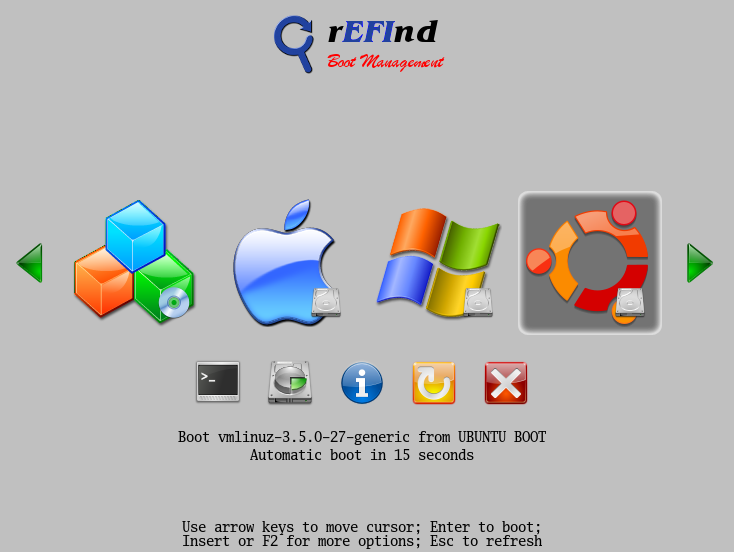UEFI - 安装指南
Views
Actions
Namespaces
Variants
Tools
前言
UEFI 通常是指已经合并的 EFI 标准和 UEFI 标准的统称,但是它不包括旧版本的 EFI v1,也不包括苹果公司(Apple)自己的非标准版本的 EFI。
目标计算机
本篇指南主要针对于在启用 UEFI、禁用安全启动(Secure boot)、以及使用 GUID 分区表的计算机上安装 Manjaro 的场景。
对于多系统启动、已经有(或者准备创建)EFI 系统分区的情况,通常需要阅读多系统安装指南。
步骤
前置步骤(Common)
1、下载您自己偏爱的 Manjaro 版本,比如 XFCE, Gnome, KDE, Budgie, Cinnamon, I3, Sway 或者 Mate。
2、把下载好的 .iso 文件烧录到 USB 或者 DVD,请移步 烧录 ISO 文件 阅读详细刻录指南。
3、检查您的 BIOS,必须启用 UEFI,以及禁用安全启动(Secure boot)。
4、启动您刚刚刻录好的 USB 或者 DVD,通过 rEFInd - 主菜单选择您想要安装的 GPU 驱动,开源驱动或者是专有驱动
* 通过开源驱动启动 - 选择 open-source - free GPU drivers
- 通过专有驱动启动 -
选择 proprietary GPU drivers from Nvidia or ATI
图形化安装
直接从 Manjaro 欢迎界面或者桌面选择 Install Manjaro 选项即可使用图形化安装器。
对于 ESP(EFI系统分区),它将用于存储 EFI Grub 二进制文件,可以在分区步骤中给一个 512mb 分区,格式化为 fat32,并将其挂在到 /boot/efi。
如果您是双系统启动的话,也可以使用之前安装的 EFI 分区。
命令行(CLI)安装
- 5-b、打开终端(terminal)并输入:
- 6、现在我们就打开命令行(CLI)安装了。
- 7、选择 1. 设置日期和时间 - 一个简单的配置
磁盘分区
* 当您 点击 2. 磁盘分区,将会出现一个对话框 "是否使用 GUID 分区表 (GPT)", 选择 Yes.
- 按自己喜欢的方式的给磁盘进行分区(手动分区方式已经超出本篇指南的范畴,可以移步这里 获取详情)
- 最重要的一步: 创建一个 50~250MB 的 EFI 分区,我自己的是 100MB (分区代码是: ef00)
设置文件系统和挂载点
* 完成分区之后,在到 4. 设置文件系统 挂载点
- 重要步骤 将您创建的 EFI 分区格式化为 VFAT 并挂载到 /boot/efi
安装
- 9. Choose 3. Install system and wait...
- 10. 至此, 到 4. 配置系统,安装自己喜欢的去配置 (用户(username), 密码(password), 镜像源(mirrorlist), 系统名(system-name)等...).
- 11. When you are done, go to 5. Install bootloader. Choose EFI_x86_64 > GRUB (2) UEFI x86_64, DON'T select BIOS GRUB.
- 11.1 It will ask to format the EFI Partition you created earlier as FAT32, yes can be chosen.
- 12. If it gives a error in the final stages saying "efivars kernel module was not properly loaded", don't worry, the system will work fine!
- 13. 如果安装器询问您是否复制 grub/efi 文件到另一个文件夹,以便在某些系统上处理兼容性,选择“是(Yes)”就可以了
- 14. Click 6. Quit
- 15. Shutdown, remove the DVD or USB, and boot. Your system should appear now!
从 BIOS 切换到 UEFI
1) You need to create an ESP (EFI System Partition).
它是一个 FAT32 分区,里边包含用于启动的 .efi 文件,您可以通过 gparted 或者 gdisk 来创建它 (大小为 200-300 MiB),并且要确保给分区设置 `boot` 和 `esp` 标记。
You should also install/check whether following packages are present:
1. efibootmgr
2. dosfstools 3. grub
2) Create the /boot/efi directory
3.) Mount the EFI partition as /boot/efi
sudo mount /dev/sdXY /boot/efi
X = Alphabet of the drive = a,b,c ... Y = Partition number of the EFI partition = 1,2,3,4...
Example - /dev/sda4
4.) Install Grub according to UEFI
5.) Update Grub configuration file.
path '/boot/grub' is not readable by Grub on boot. Installation is impossible. Aborting
另请参阅
与 Windows 多启动
In such cases rEFInd can be used.
There are two ways to install rEFInd:
1.Install rEFInd from its website (detailed) or install using pacman(preferred):
Files will be present in /usr/share/refind .
2.Or using the instructions on the rEFInd website
说明
The refind-install command can be used to automatically install rEFInd (the EFI partition may need to be mounted for this to work). See the Arch wiki for more details.
手动安装
Inside the refind folder (/usr/share/refind), copy the files and folders to /boot/efi/EFI/Boot/.
You need to copy these files to the Boot folder on your EFI partition, and the Boot folder itself will be present inside the EFI folder on the EFI Partition, so take note of it.
You can check which partition is your ESP using Gparted; find which partition is formatted as fat32 and has size around 200MiB-1GiB.
Can mount it as /boot/efi by
X=a,b,c... N=1,2,3... These depend on which partition your ESP is present which can be obtained via Gparted as mentioned earlier.
Now inside the /boot/efi/EFI/Boot/ folder, there should already be a file present:
bootx64.efi
You can rename it as windows.bootx64.efi Then you can rename refind_x64.efi to bootx64.efi
The bootx64.efi files boot by default, hence rEFInd should now boot by default, and detect grubx64.efi(linux-manjaro) and efibootmgfw.efi (windows) automatically.
So it could be like:
/boot/efi/EFI/Manjaro/grubx64.efi
rEFInd would use this file for booting Manjaro.
If you do not have this file or folder, try:
to create /boot/efi/EFI/Manjaro/grubx64.efi
另一个可选项:通过 GRUB 链式启动(chainloading)
An entry can be added to
menuentry 'Windows8 (UEFI)' {
insmod ntfs
set root=(hd0,gpt4)
chainloader (${root})/EFI/Microsoft/Boot/bootmgfw.efi
boot
}
In this case (hd0,4) or /dev/sda4 is the EFI System partition where the Windows bootloader is present.
After adding the above entry, running sudo update-grub updates the GRUB configuration file so that an entry named Windows8 (UEFI) is added to the GRUB boot menu.
The chainloading will fail on some hardware (Lenovo Ideapad 110) with the "invalid signature" message - the Refind method will still work.
额外说明
在 Windows 中使用 Rufus 创建安装媒介
Rufus users can use the following settings:
- Click on the DVD icon and load your .iso
* In the menu left of the DVD icon, select DD Image * Device: "choose your USB" (Attention: choose correctly, the device selected here will be formatted!!!) * Partition scheme: GPT partition scheme for UEFI computer * File system: FAT32 * Cluster size: "Don't modify" * Volume label: "Don't modify" * Click Start, and you are done (takes 2~5 min to complete).
意见反馈
有任何问题、建议、批评? 请发布到 这里
外链
Youtube 视频: https://www.youtube.com/watch?v=36tDZIXn3-k
